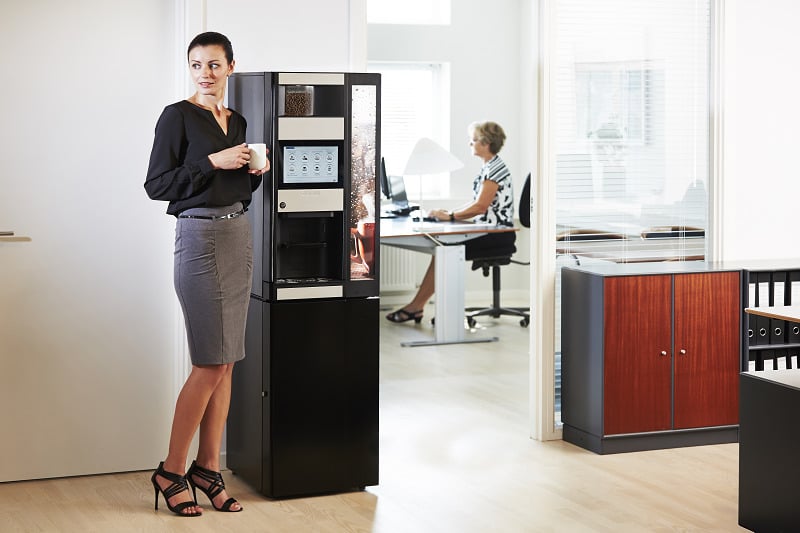Three options for a touchless user experience
1/ Mobile Ordering
The preferred means to develop a no-touch UI and UX for vending machines is via mobile ordering. With smartphones prolific and standard feature sets on modern smartphones providing multiple options for building a mobile ordering experience, Witekio has identified multiple mobile technologies that could be leveraged to address the no-touch interaction challenges.
The first would be leveraging the Wi-Fi connectivity that is ubiquitous on smartphones and mobile devices. A user could approach the vending machine, connect to the machine’s Wi-Fi, and place an order on a web interface served from the machine; there would be no need to download a vending machine application to the phone. There are numerous advantages for the vendor including no effective limits on data transfer, the use of a standard protocol, and bidirectional communication with the mobile device. On the downside, though, the user experience is less than ideal as it forces the consumer into changing connectivity settings on their device in a way that is not necessarily intuitive. Additionally, it demands that the vending machine be upgraded to serve as a Wi-Fi access point.
Bluetooth Low Energy, or BLE, is an alternative that is perhaps better suited to the vending machine use case. It is simple to integrate to even the smallest boards and consumers are used to connecting Bluetooth devices temporarily in public to address challenges. While bandwidth is more limited in comparison to Wi-Fi, the amount of information being transferred is not overwhelming and BLE can be effective in delivering the no-touch experience required.
Infrasound and ultrasound both offer interesting means of mobile communication between a mobile device and the vending machine. A user could select their products from a web or mobile interface and then – with a tap of the screen – transmit a soundwave loaded with their order information to the machine. This sound is unique and beyond the audible range for humans to detect but more than sufficient to communicate an order to the vending machine. A potential drawback, of course, is the frequently noisy locations where vending machines are found, and the need for microphone on the machine itself which is rarely standard hardware.
Near-filed communication or NFC is another option that could well align with some existing payment protocols. Consumers with NFC-equipped mobile devices have become used to transferring data via NFC and integrating this technology to machines is certainly possible. The major disadvantage, however, is that not all modern smartphones are equipped with NFC communication technology and this may limit the capacity to reach all potential consumers.
Finally, there are options, too, to take advantage of a mobile device’s flashlight feature to transmit information to the vending machine. While theoretically possible, there are not yet many implementations of this technology and so it remains mostly untested.
2/ Voice Control
Voice commands for a vending machine enable users to place an order without having to touch the machine at all. A simple request, confirmation, contactless payment, and order collection user experience avoids the user touching any screen and can be enabled using one of two options for voice parsing.
The first is an offline mode that relies on a service like Snips to interpret the voice command and process the order. Witekio has already developed a prototype of this sort of system that successfully recognizes keywords to deliver the order to the user.
The second is an online or connected mode that draws on a service from Amazon or Google, for example, to recognize keywords and place the order. Such services are incredibly effective at recognizing keywords in a variety of accents and languages, too, though it requires an always-on internet connection to enable the best user experience. Not only is such a connection unusual for vending machines, there are additional ongoing costs for the access to and use of such vocal recognition services.
In both offline and online modes, there will almost certainly need to be updates to the vending machine hardware that rarely comes with a microphone, directional or otherwise. This is potentially complex and would require equally complex maintenance interventions for each and every machine.
Additionally, as vending machines are often placed in high-traffic and noisy locations including offices, stadiums, rail stations, and shopping malls, much attention needs to be placed on the efficacy of the microphones and the voice control system as a whole in a noisy environment.
3/ Gesture Control
Two drawbacks with voice control – a noisy environment and accessibility issues for non-verbal communicators or non-native speakers of the local language – might be overcome with a gesture-based control and ordering system.
A gesture control system would see users interact with the vending machine by making hand or body gestures. For example, they could point to an item, confirm adding an item to their cart with a nod of their head or positive hand movement, and pay using a contactless card.
This technology is already popular for gaming with the Microsoft Kinect having a near 10-year history of technology development. With the arrival of Azure Kinect in 2019, cloud processing can be leveraged in order to power a vending machine UX that is entirely non-tactile.
On the downside, the machine would need to be retrofitted with gesture recognition sensors, and it would require an ongoing investment in gesture processing computing power in order to place and confirm orders from the machine even if the gesture recognition was managed outside of the cloud.
In any case, the machine will need a flexible device software update solution for voice, mobile or gesture control.


